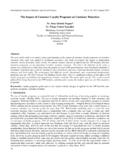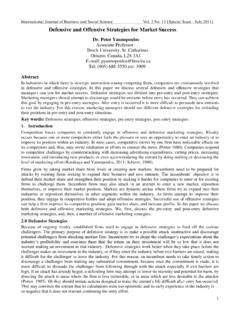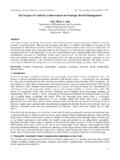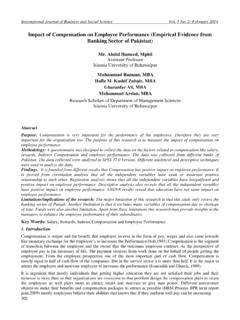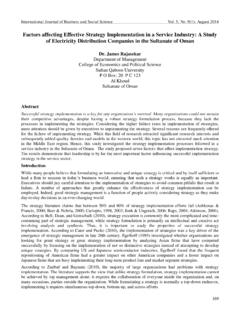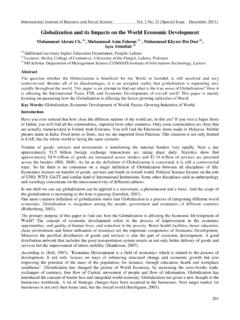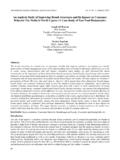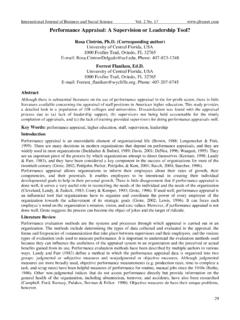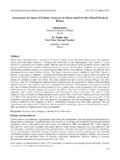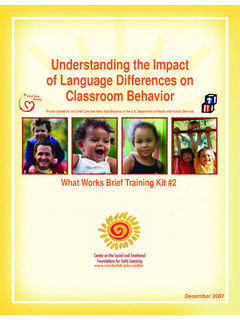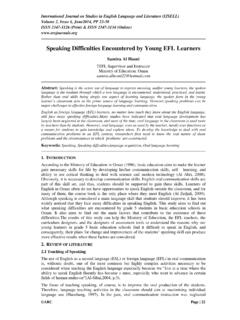Transcription of Motivation, Its Types, and Its Impacts in Language Learning
1 International Journal of Business and Social Science Vol. 3 No. 24 [Special Issue December 2012] 230 motivation , its types , and Its Impacts in Language Learning Dr. Tengku Sepora Tengku Mahadi Associate Professor School of Languages, Literacies and Translation Universiti Sains Malaysia Malaysia Sepideh Moghaddas Jafari, PhD Student School of Languages, Literacies and Translation Universiti Sains Malaysia Malaysia Abstract Given the fact that teachers are now expected to be informed enough to be able to pilot their teaching towards the varying requirements of different classroom learners, this study is proposed to shed light on what it takes to have (establish and manage)
2 An effective and successful Language classroom in terms of learners motivation . This study is designed to investigate the impact of motivation in the context of Language Learning . To reach the aim of this study, some of the main subjects, topics, and points which can be related to the goal of article are introduced and explained. Afterwards, they are followed by a brief discussion and some beneficial implications and suggestions for the teachers and lecturers. Introduction In the recent period of education, concerning Language teaching and Learning a momentous transfer and change has occurred; in the sense that an enormous focus has gone towards learner and Learning rather than teacher and teaching.
3 Nowadays, indeed, it is an important target for the teachers to make their students less dependent on teachers and more autonomous on themselves (O Malley and Chamot, 1995). In fact, learner self-sufficiency is corresponding to contemporary ideas about the active association and interest of learners, importance of learner-centered approaches, as well as sovereignty of learners from teachers (Littlewood, 1996). Moreover, one of the main and important factors in an autonomous approach in Language Learning and teaching is the learner s active cognitive processes which are called Learning strategies (LSs) (Littlewood, 1999).
4 Concerning the mentioned issues, the researchers have been always trying to discover and find out the relationship between Learning strategies and the success of Language learners. In other words, it was a high concern for the researchers to realize and understand how Learning strategies can manipulate and operate the success of Language learners. Thus, the teachers are now expected to be knowledgeable and conversant enough to be able to direct or conduct their teaching towards the varying requirements of different classroom learners.
5 This paper aims to discover and scrutinize what it takes to have (establish and manage) an efficient and successful Language classroom in terms of learners' motivation . This study, simultaneously, is designed to look into the impact of motivation in the context of Language Learning . Language Learning Strategies When someone hears the term Language Learning strategy , this question may come to his/her mind that what this term means. In general, a strategy consisted of a mental or behavioural activity related to some specific stage in the overall process of Language acquisition or Language use (Ellis, 1994, p.)
6 531). International Journal of Business and Social Science Vol. 3 No. 24 [Special Issue December 2012] 231 As Oxford (1990) asserts, Learning strategies, indeed, are particular actions taken by the learner to make Learning easier, faster, more enjoyable, more self-directed, more effective, and more transferable to new situations (p. 8). In other words, Learning strategies comprise Learning instruments for self-regulated Learning (Oxford, 2002; Dornyei, 2005). Children acquire their first Language involuntarily, unconsciously, and reflexively but adults learn a second Language by deliberately, consciously, and willfully taking on and assuming rules of Language and Learning strategies.
7 (Krashen, 1985, cited in Cook, 2000) Individual Differences It should be mentioned that in a Language Learning classroom there are varieties of learners in terms of the individual differences. Concerning this matter, Skehan (1989) tells apart some techniques and manners that good students exploit and bring into play. He goes over the main points of them as below: 1) Initially, good learners are engaged and drawn in their works, duties, and missions. 2) Good learners promote and expand the knowledge of Language as structure and arrangement and make implications and conclusions.
8 3) Good students identify and see Language as a way to make assumptions and communicate with other people. 4) Good students look safer and more comfortable about the knowledge that they are acquainted with as well as their outlook and thoughts towards a foreign Language . As a final point, they all the time evaluate and assess the scheme of the foreign Language they are Learning while definite expressions appear into mind and the link and correlation between them. Nunan (1989) judges that in a classroom there are four varieties of learners: Concrete learners, Analytical learners, Communicative learners, and Authoritative-oriented learners.
9 He believes that the Concrete learners are interested in games, pictures, films, video, tapes, talking in pairs. In addition, they like to carry out and perform English outside the class. The second type is Analytical learners. This type of learners, generally, likes to study. In other words, they like to study grammar, English books and also they like reading newspapers. Indeed, the way that they prefer to study is studying unaccompanied. Besides, they have a preference to discover their individual errors and mistakes and practice problems located and mentioned by the teacher.
10 The Third type is Communicative learners. These types of students like to be taught and are eager to gain knowledge by observing and listening to native speakers of Language . They are eager to talk to their friends in English and watch television in English. Normally and in general, they like to communicate with English in the places out of classroom. Indeed, they learn new words through listening, discussion and exchange. The fourth or the final type is Authoritative-oriented type of learners wish that the teacher make everything clear and explains about any detail.
